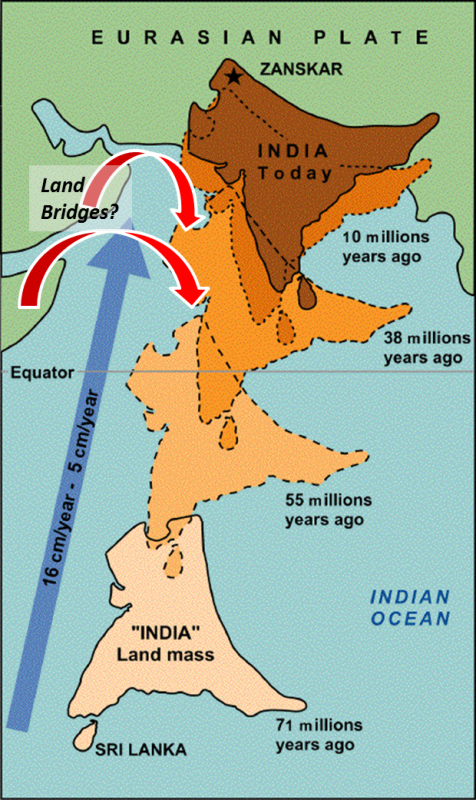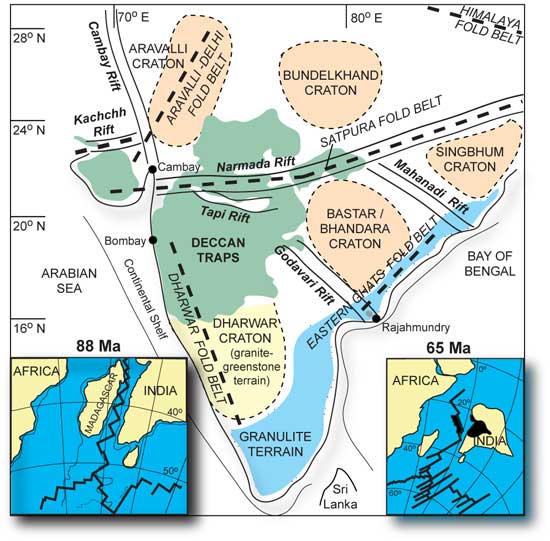-
Chapter 1: GEOLOGICAL HISTORY OF INDIA
Introduction
Theories related to the origin of the Earth have put forth various intuitions such as one that said the earth originated from the sun. It was earlier a hot gaseous mass which on cooling first turned into a liquid and then a solid. This was the gaseous hypothesis put
A more popular theory was proposed by Laplace known as the Nebular hypothesis. This proposed that the Earth was formed from the solidification of a ring thrown away by a cooling and rotating Sun. This ring was one of the several ones that condensed to form the various planets.
Another theory known as the Tidal hypothesis put forth by Jenny and Jeffreys assumes the presence of two nebula instead of one as assumed by Laplace. According to this theory a large nebula wandering in space came close to a smaller nebula. As the larger nebula wandered away from the smaller one, the matter rising in the form of a tidal wave from the smaller nebula was pulled towards it. This matter was pulled so much away from the smaller nebula that it could not go back to the parent nebula.
However it could not follow the larger nebula also and as the larger nebula pulled away, the matter was detached from the smaller nebula. On cooling the matter condensed to form the planets and they started revolving around the sun. This hypothesis is more closer to reality due to the structure of our solar systems with smallest planets located far away from the sun and larger ones located at intermediate positions.
200 million years ago India was a part of Gondwana. Indian peninsular block is a fusion of three blocks Aravali, Singbhum and Dharwad.

Fig 1: Gondwanaland and India
The Aravallis, Satpudas, eastern ghats, Vindhyas and Bijjawals are remnants of it.
Rift
valleys which are formed are Godavari, Mahanadi, Damodar towards
the Bay of Bengal.
The Narmada and son rift valleys are towards the Arabian sea.

Fig 2: Rift valleys and Peninsular block
The Indian plate separated from Gondwana and then Madagascar. It moved over reunion island and due to hotspot volcanism developed the Deccan lava plateau. The collision between Indian plate and Eurasian plate led to formation of Himalayas.
Archaen Formation (Pre Cambrian)
Geologically, the subcontinent of India was a part of the Gondwanaland (the Southern Continent). The geological history of India is described in the below sections:
Archaen Formation (Pre Cambrian)
87% of the Earth's history is of this period (4.6 billion years ago till 570 million years ago). Archean means "oldest rocks of the Earth's crust". This period saw the development of the Earth's atmosphere, the first photosynthesis, first chemosynthesis and formation of the life supporting atmosphere. Throughout the world the rocks of this period are called as "Fundamental Geinesses" OR "Basement complex". They are devoid of any form of life or sediment and form the core of all great fold mountain ranges of the world.The Archaean rocks are the repo sitories of the mineral wealth of India. These rocks are rich in ferrous and non-ferrous minerals Like iron ore, copper, manganese, mica, dolomite, lead, zinc, silver and gold. The Archaean rocks cover two-thirds of Peninsular India. In the Peninsular region, the Archaean rocks are known to be of three well-defined types:
The Bengal Gneiss
The bengal gneiss is highly foliated.
It occurs mostly in the eastern ghats
The Bundellkhand Gneiss
It is coarse grained in structure and found mostly in southern India.
It occurs mostly in Bundelkhand (UP), Baghelkhand (MP), Maharashtra, Rajasthan
The Nilgiri Gneiss
It is criss crossed and has quartz veins and is mostly like a granite.
DHARWAR SYSTEM
This geologic time extends from 2500 million years ago to 1800 million years ago. These are the first metamorphosed sedimentary rock systems in Indian geological time scale.
The Dharwar rocks are highly metalliferous. They are rich in iron ore, manganese, lead, zinc, goLd, silver, dolomite, mica, copper, tungsten, nickel, precious stones and building materials. Some of the important series of the Dharwar System are:
- Champion Series :-
Its gold mines are one of the deepest in the world,
- Champaner Series :-
It is an outlier of the Aravalli system in the vicinity of Vadodra. An attractive green variety of marble is obtained from this series
- Chlipi Series :-
It occupies parts of Balaghat, jabalpur and Chhindwara districts of Madhya Pradesh.
Closepet Series, Iron-Ore Series, Khondolite Series, Rialo Series, Sakoli Series, Sausar Series.
THE CUDDAPAH SYSTEM (THE PURANA GROUP)
The Cuddapah system is made of shales, slates, limestone and quartzite. The rocks are generally without fossils. The Cuddapah formations, named after the district of Cuddapah in Andhra Pradesh, are sedimentary-metamorphic formations.
At places the Cuddapah formations are six thousand metres in thickness. The enormous thickness of these rocks indicates the Sinking of beds of the basin with growing sedimentation.
The metallic contents in the ores of Cuddapah rocks are, however, low and at places uneconomical for extraction.
THE VINDHYAN SYSTEM
he Vindhyan System derives its name from the Vindhyan Mountain. This mountain forms a dividing line between the Ganga Plain and the Deccan Plateau.
It has enormous sedimentary deposits and at places their depth is more than 4000 metres. In some tracts, the Vindhyan rocks are buried under Deccan lava. The Great Boundary Fault (GBF) separates the Vindhyan System from the Aravallis for a distance of about eight hundred km
The Vindhyan system is well known for red-sandstone, sandstone, building material and raw materials for cement, chemical industries.
The historical buildings of Qutab Minar, Humayun's Tomb, Fatehpur Sikri, Agra Fort, Red Fort, Jama-Masjid, Birla Mandir, the Buddhist Stupa of Sanchi, etc. have been constructed from the red-sandstone obtained from the Vindhyan Ranges.
THE PALAEOZOIC GROUP (CAMBRIAN TO CARBONIFEROUS PERIOD)
This is known as the Dravidian Era in the Indian Geological Time Scale.
The Palaeozoic Era extends from 570 million years ago to 24.5 million years ago. It marks the beginning of life on the Earth's surface.
The formations of this period are almost absent in the Peninsular India except near Umaria in Rewa.
It was during this period that the Pangaea was broken and the Tethys Sea came into existence.
THE MESOZOIC ERA (THE GONDWANA SYSTEM)
The term is used for a period of geologic time in which the presence of fossil invertebrates dominated the rocks.
In the Indian Geological Time Scale, these periods extend from the Upper Carboniferous up to the beginning of the Cenozoic Era or the Aryan Era.
Most of the good quality coal deposits (bituminous and anthracite) of India are found in Gondwana formations.
The Gondwana System of rocks provides over 95% of the coal of India.
India's best and largest coal deposits are found in the Gondwana System mainly in the Damodar Valley of West Bengal,Jharkhand, the Mahanadi valley of Odisha and Chhattisgarh, the Godavari valley of Andhra Pradesh and the Satpura basin of Madhya Pradesh.
Aryan period ( Beginning of the Upper Carboniferous Period )
The Upper continent of Gondwanaland developed fissures and its broken parts started drifting away from each other. The Subcontinent of India drifted towards north and north-east to collide with the Asian land mass
The Tertiary mountain building gave birth to Himalayas.
The Subcontinent of India assumed its present shape.
Evolution and spread of man in different parts of the world.
The development and expansion of the Arabian Sea and the Bay of Bengal.
THE CRETACEOUS SYSTEM (THE DECCAN TRAP)
This period is marked by the transgression of the sea (Coromandal coast, Narmada valley) and outpouring of huge quantity of lava (basalt) so as to form the Deccan Trap.
During this period, enormous quantity of basaltic lava was poured out to the surface assuming a great thickness of over three thousand metres. The Lava Plateau (the Deccan Trap) is the result of that lava eruption.
The lava plateau of India (Deccan Trap) has a maximum thickness of about 3000 m along the coast of Mumbai from where it decreases towards south and east.
THE TERTIARY SYSTEM (THE CENOZOIC ERA)
Cenozoic means recent life. The beginning of the Tertiary Period js about 65 million years ago. Fossils in these rocks include many types, closely related to modern forms, including mammals, plants and invertebrates.
During this Period, as India collided with Tibet, the sediments which had been accumulating in the Tethys basin had begun to rise by a slow rise of ocean bottom. The upheaval of the Himalayas altered the old topography of the subcontinent.
There is enough evidence to prove that the Himalayas are still rising.
THE QUATERNARY PERIOD (THE PLEISTOCENE AND RECENT FORMATIONS)
The Northern Plains of India came into existence during the Pleistocene Period
The Pleistocene period is marked by Ice Age and glaciation on a large scale in the Northern Hemisphere.
The moraine deposits and the karewa formations of Kashmir Valley are of the Pleistocene period
The river terraces of the Narmada, Tapi, Godavari, Krishna, and Kaveri, etc. are also of the Pleistocene Period.
Points to Remember
The karewas are the lacustrine deposits of the Pleistocene period.
The karewas of Kashmir are generally found along the lower slopes of Pir-Panjal with a dip towards the Kashmir Valley.
They are well known for the cultivation of saffron, almond and walnut.
Solved Question Papers
Q.Which of the following pairs of States of India indicates the easternmost and Westernmost State? (UPSC CSAT 2015)
Assam and Rajasthan
Arunachal Pradesh and Rajasthan
Assam and Gujarat
Arunachal Pradesh and Gujarat
Ans . D
west of the line falls in Gujarat, while the east falls in Arunachal Pradesh.
Q.Consider these pairs
1. Cardamom Hills - >Coromandel Coast
2. Kaimur Hills -> Konkan Coast
3. Mahadeo Hills - >Central India
4. Mikir Hills - > North-East India
Which of the above pairs are correctly matched? (UPSC CSAT 2014)
1 and 2
2 and 3
3 and 4
2 and 4
Ans . C
Kaimur hills is in central highlands, far away from Konkan Coast.
Chapter Review
Score more than 80% marks and move ahead else stay back and read again!